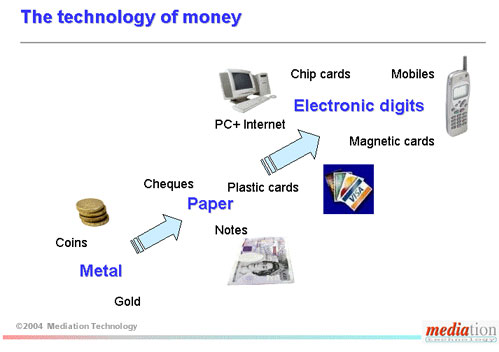A Cambridge perspective
on the digital world

This page is part of Mediation Technology's archives
April 2004
Paying by mobile: from fantasy to reality
'Mobile payment' is a simple, and undeniably attractive, concept: the idea that you can use your mobile phone - a device now owned by more than 80% of the population in countries such as the UK - to pay for a wide range of goods and services.
But dealing with the detail is not quite so straightforward. Our research has identified 32 different types of mobile payment, depending for example on whether information or physical goods are being purchased, whether the amounts are large or small, and whether 'remote' or 'proximity' payments are involved.
As mobile payment shifts from a future fantasy to everyday reality, workable solutions are being found for these different types of payment need. But this does not necessarily mean a universal, 'one size fits all' mobile payment system - not yet, anyway.
A universal solution?
The barriers to introducing a universal mobile payment solution are not technical. In the non-mobile world a diversity of different payment solutions already exist, which are designed for different purposes, and which meet different sets of requirements.
Credit cards are not used for small value payments: the inconvenience and the cost of processing are too high. Cash is not used for large payments, due to the risk of theft and the physical problems of handling large cash sums. Account payments are convenient for some purposes - but, depending on the terms on which they are offered, can be costly for users.
A large number of organisations have been set up to operate, administer and regulate these different forms of payment - banks, clearing houses, credit card companies, financial service organisations of many different types, and national and international regulators. There are national differences in culture and practice: credit cards, for example, are not widely used in Japan.
Complex sets of regulations and legal frameworks accompany every type of payment, together with custom, practice and expectation about what happens in different situations. Some of these frameworks of law, regulation and custom have evolved over years, decades or even centuries. They are unlikely to change overnight.
 Mobile
payment: theory and practice
Mobile
payment: theory and practice
In theory, mobile technology could meet the requirements of all of these payment types. The technology of money is shifting - in fact for all practical purposes it has already shifted - from paper to electronic digits. Mobiles now seem the obvious way for people to interact with a financial system whose internal workings are already digital, online and networked.
Mobile systems can process even very small payments cost effectively, as premium text demonstrates. Mobile payments can also be given a high degree of security.
In practice, what is most likely to happen - at least in the short term - is a piecemeal approach, as organisations introduce solutions that meet specific sets of needs. At present, two types of practical payment solution are emerging:
1. Mobile access to payment systems which already exist - such as credit cards, and payment accounts;
2. New forms of payment specific to mobile, with their own unique characteristics - such as premium text and i-mode.
Today, introducing a successful mobile payment system means understanding the precise requirements - such as the type of goods, and the amounts involved - and matching these to the practical solutions available.
Some mobile payment solutions may well have more general uses, once they are shown to work and are accepted by users. This practical 'bottom up' approach is more likely to produce results, we believe, than a theoretical attempt to introduce a 'solution for everything'.
Mobile vs Internet vs cards
Mobiles offer some significant advantages over the Internet, which has become the standard method of 'online' payment. Mobiles are more secure, more personal, and can be used anywhere. Mobiles already have a well developed account/payment system (for paying mobile phone bills); and they are more widely used, by more people, than PCs.
Mobiles also offer advantages compared with credit cards. They already have personal identity chips, similar to those in the latest 'chip and PIN' cards. They also have built-in processing power, networked communications, and a keyboard and screen. Mobile networks even have a built-in tracking system, which could be used to discourage unauthorised use.
Many people have an emotional attachment to their mobile, which they regard almost as an extension of themselves. A recent report suggested that it takes, on average, 26 hours to notice and report a stolen wallet; stolen mobiles are reported, on average, after 68 minutes.
Mobile solutions
Mobile payment solutions are already available to fit a wide range of specific needs; in many cases, a practical solution can be put together simply and cost effectively. In other cases, a system can be assembled from a standard 'kit of parts'.
Finding the right solution means understanding the precise requirements, and matching it to what is available. 'Going mobile' can produce unexpected benefits, giving access to completely new customers and creating a new channel to market.
©2004 Mediation Technology


